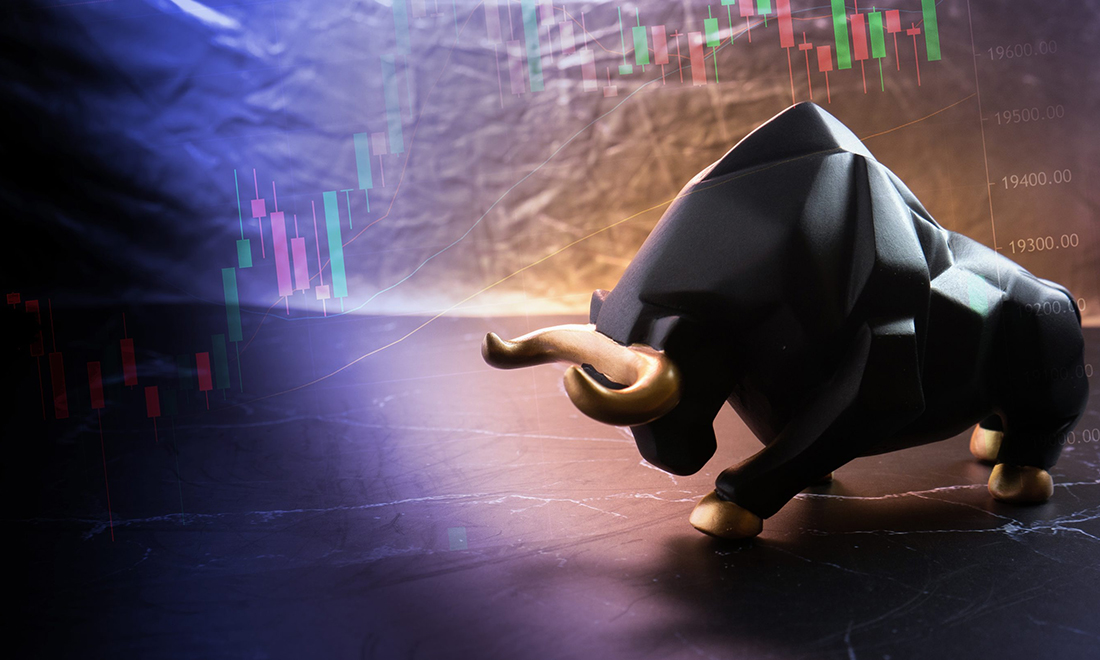
对于这位(资深)作者来说,就在海量数据的基础上提供更有根据的、更令人信服的对多种资产类别未来投资回报的预测而言,没有任何来源能与Research Affiliates相媲美。该来源现在对美国大盘股(2023年迄今为止的反弹行情)的预测确实令人警醒。
基于对通胀和收益的预期,Research Affiliates预计标准普尔500指数未来10年的年实际回报率仅为2%,与过去10年的年回报率相比微乎其微。
Research Affiliates(以下简称RA)是一家为太平洋投资管理公司(Pimco)、嘉信理财(Charles Schwab)和景顺(Invesco)等管理公司设计1300亿美元共同基金和交易所交易基金(ETFs)投资策略的公司。它创建了一个被称为“基本面指数”的模板,该模板不以美元价值来衡量股票,而是以现金流、销售额和股息等基本指标来衡量股票。因此,该公司的RAFI基本面基金在结构上避免了最昂贵的股票占总资产比例越来越高的情况,这对于传统指数基金、交易所交易基金和其他基于股票市值分配的“市值加权”工具来说是个大问题。RA创始人罗伯·阿诺特(Rob Arnott)曾任《金融分析师期刊》(Financial Analysts Journal)主编,是投资组合管理领域的顶尖学术思想家之一。RA的首席执行官兼首席投资官克里斯·布莱曼(Chris Brightman)也是投资行业中著名的以科学为基础的数据分析大师之一。
RA网站上有一张“资产交互配置”地图,显示了该公司对30多种投资类别的10年总回报预测,从新兴市场到房地产投资信托基金(REITs),从通货膨胀保值债券(TIPS)到大宗商品。这些数字是基于“回归均值”原则得出的。例如,在预测估值变化时,RA预测未来10年,市盈率(P/Es)将从当前水平向长期平均水平移动。该公司还认为,每股收益将增长至接近历史标准的水平,而忽略了华尔街分析师通常提出的持续两位数增长的乐观预测。
市盈率的下降和利润的温和增长将意味着未来的低收益
在其美国大盘股的表格中,RA预测,到2033年,每股收益(EPS)平均每年将增长5.4%。这个数字相当于2.5%的“实际”涨幅,因为RA预计年通胀率将达到2.9%,远高于美联储2%的目标。与2013年年中至2023年年中这段时间相比,2.5%的利润增幅听起来低得惊人,而那段时间利润平均每年高出通胀5.2个百分点,但从历史标准来看,这一增幅实际上相当不错。久负盛名的研究表明,长期来看,每股收益滞后于GDP,因为企业会进行稀释性收购,而新进入者会榨干曾经由老牌企业瓜分的销售额和利润池。RA的观点暗示,每股收益很可能“跑赢”经济,因为其扩张速度快于经济增长速度;国会预算办公室(Congressional Budget Office)预测,到2033年,GDP的年增长率将仅为1.7%至1.8%。因此,RA对收益持合情合理却也相当乐观的看法。
相比之下,华尔街分析师预计,仅从今年第一季度到2024年底,标准普尔500指数成分股每股收益将增长29%,在短短七个季度内就达到RA 10年预测的40%以上。
RA预计股息的年回报率将增加1.7%,接近目前的收益率。加上股息率和预期收益增长率,预计年回报率为7.1%。但如果市盈率稳定在今天25倍的水平,这就是你能获得的总回报。但根据RA的最佳估计,这是不可能发生的。
该公司预计,基于过去12个月利润计算的标准普尔500指数的市盈率,将降至近几十年的正常水平。但这再一次表明,这种看法并不悲观。RA预计市盈率将从25降至20.4,这一数字与过去30年的中位数相近。如果市盈率保持在目前的25倍,那么股价的年收益将从5.4%下降2.2个百分点,降至仅3.2%。3.2%的年资本收益加上1.7%的股息率,RA的总回报率为4.9%。
根据RA公式,标准普尔500指数10年后的表现如何?3.2%的年净涨幅意味着,标准普尔500指数将在2033年6月触及6000点,仅比6月22日的收盘价4381点高出37%。
与过去10年相比,这一预测看起来尤其糟糕
最重要的衡量标准是4.9%的年收益给你带来的额外购买力。在2.9%的预期通胀率下,你投资组合中的美元将只比食品价格、租金和所有其他费用(4.9%的总收益减去2.9%的预期通胀率)的增长快2%。换句话说,主要是因为投资大盘股的起点太高了,未来10年你可能只能获得2%的实际年回报率。
与过去10年的暴利相比,这一数字似乎几乎是无法想象的。从2013年年中到2023年年中,标准普尔500指数经通胀因素调整后的年总回报率为10.1%。这是RA认为未来10年最有可能实现的年总回报率的五倍。提示一下。散户和基金可以在2013年第二季度以17.6倍的市盈率买入标准普尔500指数。股价将比现在便宜30%。这些便宜的股票为高回报开辟了道路。展望未来,与过去相反的动态将占据主导地位。在获得巨大收益之后,会出现低回报时期。这就是市场跷跷板回归平衡的方式。未来几年可能会出现这样的严峻形势。(财富中文网)
译者:中慧言-王芳
对于这位(资深)作者来说,就在海量数据的基础上提供更有根据的、更令人信服的对多种资产类别未来投资回报的预测而言,没有任何来源能与Research Affiliates相媲美。该来源现在对美国大盘股(2023年迄今为止的反弹行情)的预测确实令人警醒。
基于对通胀和收益的预期,Research Affiliates预计标准普尔500指数未来10年的年实际回报率仅为2%,与过去10年的年回报率相比微乎其微。
Research Affiliates(以下简称RA)是一家为太平洋投资管理公司(Pimco)、嘉信理财(Charles Schwab)和景顺(Invesco)等管理公司设计1300亿美元共同基金和交易所交易基金(ETFs)投资策略的公司。它创建了一个被称为“基本面指数”的模板,该模板不以美元价值来衡量股票,而是以现金流、销售额和股息等基本指标来衡量股票。因此,该公司的RAFI基本面基金在结构上避免了最昂贵的股票占总资产比例越来越高的情况,这对于传统指数基金、交易所交易基金和其他基于股票市值分配的“市值加权”工具来说是个大问题。RA创始人罗伯·阿诺特(Rob Arnott)曾任《金融分析师期刊》(Financial Analysts Journal)主编,是投资组合管理领域的顶尖学术思想家之一。RA的首席执行官兼首席投资官克里斯·布莱曼(Chris Brightman)也是投资行业中著名的以科学为基础的数据分析大师之一。
RA网站上有一张“资产交互配置”地图,显示了该公司对30多种投资类别的10年总回报预测,从新兴市场到房地产投资信托基金(REITs),从通货膨胀保值债券(TIPS)到大宗商品。这些数字是基于“回归均值”原则得出的。例如,在预测估值变化时,RA预测未来10年,市盈率(P/Es)将从当前水平向长期平均水平移动。该公司还认为,每股收益将增长至接近历史标准的水平,而忽略了华尔街分析师通常提出的持续两位数增长的乐观预测。
市盈率的下降和利润的温和增长将意味着未来的低收益
在其美国大盘股的表格中,RA预测,到2033年,每股收益(EPS)平均每年将增长5.4%。这个数字相当于2.5%的“实际”涨幅,因为RA预计年通胀率将达到2.9%,远高于美联储2%的目标。与2013年年中至2023年年中这段时间相比,2.5%的利润增幅听起来低得惊人,而那段时间利润平均每年高出通胀5.2个百分点,但从历史标准来看,这一增幅实际上相当不错。久负盛名的研究表明,长期来看,每股收益滞后于GDP,因为企业会进行稀释性收购,而新进入者会榨干曾经由老牌企业瓜分的销售额和利润池。RA的观点暗示,每股收益很可能“跑赢”经济,因为其扩张速度快于经济增长速度;国会预算办公室(Congressional Budget Office)预测,到2033年,GDP的年增长率将仅为1.7%至1.8%。因此,RA对收益持合情合理却也相当乐观的看法。
相比之下,华尔街分析师预计,仅从今年第一季度到2024年底,标准普尔500指数成分股每股收益将增长29%,在短短七个季度内就达到RA 10年预测的40%以上。
RA预计股息的年回报率将增加1.7%,接近目前的收益率。加上股息率和预期收益增长率,预计年回报率为7.1%。但如果市盈率稳定在今天25倍的水平,这就是你能获得的总回报。但根据RA的最佳估计,这是不可能发生的。
该公司预计,基于过去12个月利润计算的标准普尔500指数的市盈率,将降至近几十年的正常水平。但这再一次表明,这种看法并不悲观。RA预计市盈率将从25降至20.4,这一数字与过去30年的中位数相近。如果市盈率保持在目前的25倍,那么股价的年收益将从5.4%下降2.2个百分点,降至仅3.2%。3.2%的年资本收益加上1.7%的股息率,RA的总回报率为4.9%。
根据RA公式,标准普尔500指数10年后的表现如何?3.2%的年净涨幅意味着,标准普尔500指数将在2033年6月触及6000点,仅比6月22日的收盘价4381点高出37%。
与过去10年相比,这一预测看起来尤其糟糕
最重要的衡量标准是4.9%的年收益给你带来的额外购买力。在2.9%的预期通胀率下,你投资组合中的美元将只比食品价格、租金和所有其他费用(4.9%的总收益减去2.9%的预期通胀率)的增长快2%。换句话说,主要是因为投资大盘股的起点太高了,未来10年你可能只能获得2%的实际年回报率。
与过去10年的暴利相比,这一数字似乎几乎是无法想象的。从2013年年中到2023年年中,标准普尔500指数经通胀因素调整后的年总回报率为10.1%。这是RA认为未来10年最有可能实现的年总回报率的五倍。提示一下。散户和基金可以在2013年第二季度以17.6倍的市盈率买入标准普尔500指数。股价将比现在便宜30%。这些便宜的股票为高回报开辟了道路。展望未来,与过去相反的动态将占据主导地位。在获得巨大收益之后,会出现低回报时期。这就是市场跷跷板回归平衡的方式。未来几年可能会出现这样的严峻形势。(财富中文网)
译者:中慧言-王芳
For this (veteran) writer, no source provides more data-rich, well-founded, and convincing forecasts for future investment returns in multiple asset classes than Research Affiliates. And what that source now foresees for U.S. big-cap stocks, the comeback kids so far in 2023, is sobering indeed.
Based on its expectations for inflation and earnings, Research Affiliates expects the S&P 500 to deliver real returns of just 2% a year for the next decade—a tiny fraction of their annual returns over the past 10 years.
Research Affiliates is a firm that designs investment strategies for $130 billion in mutual funds and ETFs for such managers as Pimco, Charles Schwab, and Invesco. It created a template called “fundamental indexing” that weights stocks not by their dollar value, but by such bedrock measures as cash flow, sales, and dividends. The firm’s RAFI-branded fundamental funds are hence structured to avoid putting a bigger and bigger percentage of total holdings in the most expensive stocks, a big problem for traditional index funds and ETFs and other “cap-weighted” vehicles where allocations are based on stocks’ market capitalization. RA founder Rob Arnott is the former editor-in-chief of Financial Analysts Journal, and ranks among the top academic thinkers in portfolio management. RA’s CEO and chief investment officer, Chris Brightman, is also one of the leading masters of scientifically based data analysis in the investment industry.
The RA website features an “Asset Allocation Interactive” map that shows the firm’s 10-year total return projections for three dozen investment categories, from emerging markets to REITs, from TIPS to commodities. The numbers are based on the principal of “reversion to the mean.” In predicting changes in valuation, for example, RA forecasts that over the next decade, price/earnings ratios (P/Es) will move from their current levels toward their long-term averages. It also deems that earnings per share will expand close to historical norms, and ignores the bluebird predictions of consistent, double-digit growth usually posited by Wall Street analysts.
Falling P/Es and modest profit growth will mean low future returns
In its table for U.S. large caps, RA predicts that earnings per share (EPS) will rise, on average, at 5.4% a year through 2033. That number equates to 2.5% “real” gains, since RA foresees inflation running at a 2.9% annual pace, well above the Federal Reserve’s 2% target. That 2.5% profit growth figure sounds shockingly low when compared with the period from mid-2013 to mid-2023, when profits beat inflation by an average of 5.2 percentage points a year, but it’s actually pretty good by historical norms. Well-regarded research shows that over the long run, EPS lags GDP as companies make dilutive acquisitions and new entrants drain the sales and profit pools once divided among entrenched stalwarts. The RA view implies that EPS may well “outperform” by expanding faster than the economy; the Congressional Budget Office predicts that GDP will grow at just 1.7% to 1.8% a year through 2033. Hence, RA is taking a sound but fairly optimistic view on earnings.
By contrast, Wall Street analysts are positing that S&P 500 EPS expands by 29% from Q1 of this year through the end of 2024 alone, achieving over 40% of the RA 10-year forecast in just seven quarters.
RA predicts an additional 1.7% annual return from dividends, close to the current yield. Add the dividend yield and projected growth in earnings, and you get 7.1%. But that’s the total return you’d garner if the P/E stays steady at today’s level of 25. By RA’s best estimates, that’s not going to happen.
The firm sees the 500 P/E, based on trailing, 12-month profits, contracting toward its norm of recent decades. But once again, the take is hardly pessimistic. RA foresees a decline in the multiple from 25 to 20.4, a figure that’s around the median for the past 30 years. The almost five-point shrinkage reduces yearly gains in stock prices from the 5.4% they’d register if the P/E stayed at the current 25, by 2.2 points a year, to an annual pace of just 3.2%. Add that 3.2% in annual capital gains to the 1.7% dividend yield, and you get the RA total return of 4.9%.
Where does the RA formula see the S&P 500 index 10 years hence? The net 3.2% annual increase in share prices would mean the 500 hits 6000 in June of 2033, just 37% above its close of 4381 on June 22.
The forecast looks especially bad compared with the past decade
The most important measure is the additional buying power the 4.9% annual gains will give you. At 2.9% projected inflation, the dollars in your portfolio will grow only 2% faster than the increase in food prices, rent, and all other expenses (that 4.9% total gain minus 2.9% projected inflation). Put another way, largely because the starting point for investing in big-caps is so expensive, you’re likely to garner only 2% real, annual returns over the next decade.
Compared with the bounty of the past 10 years, that number seems almost inconceivable. From mid-2013 to mid-2023, the S&P 500 delivered a total, inflation-adjusted yearly return of 10.1%. That’s five times what RA deems most likely for the next decade. Just a hint. Folks and funds could buy the index in Q2 of 2013 at a P/E of 17.6. That’s 30% cheaper than today. Those bargain prices opened the way to the high returns. Moving forward, the opposite dynamic will take charge. Periods of low returns follow episodes of outsize gains. That’s how the market seesaw shifts back into balance. And that’s the grim dynamic likely to reign in the years ahead.






